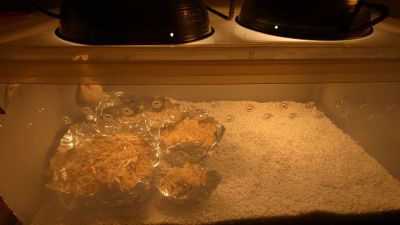Setting Up a Mushroom Fruiting Chamber
The whole idea behind a DIY mushroom house is to simulate the natural growing conditions of fungi, that is, recreating a humid forest. Mushrooms love high humidity, a bit of light, and excellent airflow. Commercial growers spend serious dollars on building energy intensive, air-, humidity-, and temperature-regulated grow rooms or underground tunnels. Creating a DIY mushroom house doesn’t have to be costly or nearly that comprehensive.
Requirements for Growing Mushrooms at Home
There are numerous mushroom fruiting ideas out there. What they all have in common is attention to providing the correct CO2 (carbon dioxide), humidity levels, temperature, and amount of light. Ideally, the CO2 will be under 800 ppm, depending upon the type of mushroom. There should be sufficient light to see by. Humidity should be above 80 percent in the fruiting chamber and the temperature between 60-65 degrees F. (16-18 C.) for some varieties. For example, oyster mushrooms need different humidity and temps than shiitakes, which like it colder. Look up the exact requirements for the specific type of mushrooms you’re growing at home. Start with inoculated, sterilized jars with cultures that are nicely colonized.
How to Make a Mushroom Fruiting Chamber
The absolute simplest mushroom fruiting house involves the use of a clear plastic storage bin with a lid. Drill 4-5 holes into all sides of the container. Wash the container and dry it thoroughly. Pour 4-8 dry quarts (4.4 to 8.8 liters) of perlite into the bottom of the container and add water until it is absorbed and the perlite is wet but not sodden. If you add too much water, drain the perlite so it is barely dripping. Aim on having 2-3 inches (5-7.6 cm.) of this wet perlite at the bottom of the container. Find a good place for your fruiting chamber. Remember this area should comply with the above info regarding CO2, humidity, temperature, and lighting. Now it’s time to transfer the colonized mushrooms. Wear sterile gloves or use hand sanitizer prior to handling the mushroom culture. Gently remove the cake of mushroom culture and set it down into the damp perlite in the chamber. Space each cake a few inches (7.6 cm.) apart on the chamber floor. Mist the inoculated cakes with distilled water no more than twice a day and fan them using the plastic storage lid. Be careful about getting the cakes too wet; they might mold. Use only a very fine misting bottle and hold it away from, but above, the cakes. Also, mist the lid of the container. Keep the temperature and humidity level as consistent as possible. Some mushrooms like it hot and some cold, so be sure to look up the requirements for your type of mushroom. If need be, use a fan to move the air around, and during colder months, a humidifier and heater will help to maintain a consistent temp and humidity level. This is just one DIY mushroom fruiting house idea and a fairly simple one. Mushrooms also can be grown in buckets or clear plastic bags that have been placed in a glass chamber outfitted with a humidifier and fan. Mushrooms can be grown in almost anything your imagination comes up with as long as it fulfills the above requirements for consistent CO2, humidity, temperature and light.
